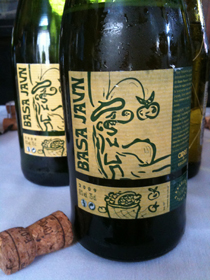How bout them apples? Basa Jaun cider
 Cider is fascinating. In Botany of Desire, Michael Pollan tracks the history of the apple. It turns out that because the apples that proliferated in early 19th century America were tart or mushy, they were cultivated to provide fruit for cider, a fermented (read: alcoholic) drink. This is why Johnny Appleseed was welcomed so warmly in every cabin in Ohio and beyond, Pollan says, calling him “the American Dionysus,” elaborating, “he was the guy bringing the booze.”
Cider is fascinating. In Botany of Desire, Michael Pollan tracks the history of the apple. It turns out that because the apples that proliferated in early 19th century America were tart or mushy, they were cultivated to provide fruit for cider, a fermented (read: alcoholic) drink. This is why Johnny Appleseed was welcomed so warmly in every cabin in Ohio and beyond, Pollan says, calling him “the American Dionysus,” elaborating, “he was the guy bringing the booze.”
I’ll never be as into cider as I am into wine. But the diverse varieties of apples produce different juice–maybe there’s also a terroir of cider? And it is a pity, as Pollan points out that many of diverse varieties of (cider) apples have been crowded out in favor of a few, sweet apple varieties such as Delicious.
Enter Basa Jaun cider, which I tried the other day at the distributor tasting for de Maison Selections. Made in the French Basque country, it comes from 15 different varieties including Ondo Motxa, Eri Sagarra, Anisa, Gordin Xuri, Minxuri, Azau sagarra, Eztirotxia, Geza Xuria, Mandoburua, and Patzulua–how bout them apples? It’s really a fun drink, with apple-y notes (go figure), balanced between sweet and tart, with a faint sparkle and low in alcohol. I could see it working at a weekend lunch with some savory crepes (but who really has savory crepes at lunch in America?) or even chips and salsa. Oh, and Basajaun is apparently a hirsute, forest-dwelling protector of livestock, inron-worker and agricultural sensei in Basque legend.




On May 16th, 2011 at 5:27 pm ,Inigo wrote:
Basa JAUN, basque mythology, the Lord of the Woods, a sort of basque Yeti.
Juan is simply John.
Regards
On May 16th, 2011 at 5:31 pm ,Dr. Vino wrote:
Thanks, Inigo, for correcting my Basque!
On May 17th, 2011 at 10:32 am ,1WineDude wrote:
I don’t understand this “history of the apple” of which you speak, Tyler. Surely apples were created in the garden of eden or the talking snake wouldn’t have been able to tempt Eve?
😉
On May 17th, 2011 at 11:03 am ,Randall Grahm wrote:
Apples (or pears) may well be capable of expressing terroir. (Or in the case of pears, pearoir – so sorry). Just witness what Eric Bordelet has managed to achieve with his Poire “Granit,” made from 300 year old pear trees (that tower at 100 ft.) “Standard pome trees are grown from seeds, which have a very deep rooting habit – hence more drought tolerant, longer-lived and potentially a lot more expressive of terroir. Dwarf fruit trees, usually grown from rootstock cuttings are more shallow rooted, don’t live so long, are typically drip irrigated and produce a rather lackluster product, lacking in the depth of a dry-farmed product. Vive le terroir des pommes!
On May 17th, 2011 at 4:25 pm ,Dr. Vino wrote:
Meant to include this link to the producer in the post but forgot. So here it is: http://www.domainebordatto.com/basa.php
1winedude – history of *commercial* apple cultivation…
Randall – Thanks for stopping by. Interesting about the various propagation methods influencing the taste of the fruit. Do you see similarities with grape vines? Is that one of the theories behind your new vineyard at San Juan Bautista?
On May 17th, 2011 at 5:53 pm ,Randall Grahm wrote:
This is precisely the theory I’m working on. Don’t know if apples can ultimately be as articulate about their terroir as grapes might be, but certainly dry-farmed apples, and very likely older trees may well be capable of expressing nuances of difference. My sense is that some transformative process (fermentation) may be needed to help further amplify these differences. The idea of growing grapes from seeds is untested and there are really two reasons why seeds haven’t caught on. With seeds, every plant is a little (or a lot) different from every other one, and therefore all may not be suitable for one’s purposes. For purposes of tree grafting, this doesn’t appear to be a big problem. The second, perhaps larger problem for grape seeds is that plants grown from grape seeds may tend to throw off suckers forever if the primary bud whorl is not properly and completely disbudded. This makes it a major pain in the bud forever. With the right tools ((straight edged-razor) and careful work, this problem should be theoretically avoidable. But since it is a lot of work, virtually everyone has taken the easier route and gone w/ vegetative propagation (cuttings).
On May 18th, 2011 at 2:39 pm ,The other Spain, as brought to us by Andre Tamers [importer] | Dr Vino's wine blog wrote:
[…] already mentioned the fascinating Basa Jaun cider but there is also the Isastegi Basque cider, from the Spanish side of the border. Dry! Yeasty! […]
On May 19th, 2011 at 4:05 pm ,Athena Rork wrote:
I live in Burlington, Vermont and we actually have a fantastic crepery down the street from our house, The Skinny Pancake. There should definitely be more in America!
On January 8th, 2013 at 10:09 pm ,Toni wrote:
This sounds so much better than the bottle we tried tonight. It smelled of paint thinner. Really strange. I wonder if it has gone bad or something. Any idea? Definitely will try again from another store! Thanks.